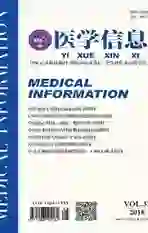生物标记物在肺挫伤中的应用价值
2018-06-17阚强波田灿琼付玉东王俊峰侯波洪志鹏
阚强波 田灿琼 付玉东 王俊峰 侯波 洪志鹏
摘 要:急性炎症反应在肺挫伤的病理生理学中的重要作用已得到广泛认可,炎症反应是肺挫伤后病情演变加重的主要因素。肺挫伤与急性肺损伤和急性呼吸窘迫综合症的发生具有临床相关性已形成共识,然而免疫学评分和方法用于检测和评估肺挫伤的严重程度在临床中还没有建立,一种可能的方法是通过监测常规炎症标记物反映肺挫伤后发生的免疫反应。国外相关研究已表明炎症直接相关的生物标志物,如促血管生成素2、白介素6和降钙素原与炎症间接相关的标记物如人五聚素3和肾上腺髓质素原,它们都是ARDS的独立潜在危险因素。
关键词:生物标记物;肺挫伤;急性呼吸窘迫综合症
中图分类号:R563 文献标识码:A DOI:10.3969/j.issn.1006-1959.2018.08.011
文章编号:1006-1959(2018)08-0031-04
Application Value of Biomarkers in Lung Contusion
KAN Qiang-bo1,TIAN Can-qiong1,FU Yu-dong1,WANG Jun-feng1,HOU Bo1,HONG Zhi-peng2
(1.Department of Thoracic Surgery,the First People's Hospital of Qujing City,Qujing 655000,Yunnan,China;
2.Department of Thoracic Surgery,First Affiliated Hospital of Kunming Medical University,Kunming 650000,Yunnan,China)
Abstract:The important role of acute inflammatory reaction in the pathophysiology of lung contusion has been widely recognized. Inflammatory reaction is the main factor of exacerbation of the disease after lung contusion.There is a consensus that there is a clinical correlation between lung contusion and the occurrence of acute lung injury and acute respiratory distress syndrome.However, immunological scores and methods for detecting and evaluating the severity of lung contusion have not been established in clinical practice.One possible method is to monitor routine inflammatory markers to reflect the immune response after lung contusion.Foreign studies have shown that biomarkers directly related to inflammation,such as angiopoietin 2,interleukin 6 and calcitonin,are indirectly associated with inflammation,such as human pentagglutinin 3 and adrenomedullin,they are independent potential risk factors for ARDS.
Key words:Biomarkers;Pulmonary contusion;Acute respiratory distress syndrome
由美国和欧洲组成的关于急性呼吸窘迫综合症的研究团队定义,肺挫伤(pulmonary contusion,PC)是导致急性肺损伤(acute lung injury,ALI)和急性呼吸窘迫综合症(acute respiratory distress syndrome,ARDS)的最主要原因[1]。临床上肺挫伤影像所见的肺挫伤范围与临床症状不一致,提示肺挫伤的病理生理学中可能有細胞水平与亚细胞水平损伤、炎症以及肺挫伤与其它潜在损伤如误吸、感染等相互作用共同参与,相关研究表明炎症反应在肺挫伤患者的病情进展中发挥重要的作用[2]。这种炎症反应也有延迟发生的情况,因为它也“引发”炎症细胞对随后产生的刺激过度反应,被称为第二次撞击现象,这就是临床观察考虑到的临床症状发作延迟现象,由于对炎症立即和延迟反应的影响,潜在可以使用的预防措施存在于肺挫伤持续期间的治疗窗口[3]。与炎症相关的一些生物标记物是否能作为反映肺挫伤病情严重程度的指标,现将一些相关研究综述如下。
1 降钙素原在肺挫伤中的应用价值
肺挫伤后炎症反应在病情进展中发挥重要作用,肺微血管炎症、血管通透性增加与非心源性水肿是肺挫伤进展为ARDS的标志,它们都离不开炎症反应的参与[4]。细胞因子作为炎症反应的媒介起到炎症放大的效应,各种炎症性肺损伤均通过各种可溶性细胞因子和趋化因子来调节炎症细胞的作用和细胞间相互作用 [5]。细胞因子的趋化作用在多种原因所致肺损伤的发生、发展和转归中扮演着重要角色。降钙素原(procalcitonin,PCT)作为一种次级炎症因子也参与其中。
在早期ARDS和ALI阶段PCT作为细胞免疫活性增强的标记物有重要价值。Tsantes等[6]在关于测定血浆和支气管肺泡灌洗液中PCT和白细胞介素6(interleukin-6,IL-6)来区分脓毒血症或非脓毒血症引起的ARDS研究中表明:早期血浆PCT浓度,但不是支气管肺泡灌洗液中PCT浓度可以帮助区分脓毒症和非脓毒血症导致的ARDS,血浆PCT浓度还与多器官功能障碍综合症的严重程度相关。在非常严重的肺挫伤患者的支气管肺泡灌洗液中能检测到PCT,但支气管肺泡灌洗液中的PCT评估肺挫伤的严重程度不是一个可靠的指标[7]。Lederer等[8]的研究结果表明支气管灌洗液中PCT的水平在ARDS与ALI患者中没有差异,然而血清PCT浓度在ARDS与ALI患者中有明显差异,ARDS患者血清中PCT的水平明显高于ALI患者,血清中PCT水平与肺损伤严重程度相关,血清PCT水平在并发脓毒血症或非脓毒血症的ARDS/ALI患者没有差异,支气管肺泡灌洗液中产生的PCT非常低,血清中PCT水平是评估ARDS患者肺损伤严重程度的有用参数。在ARDS早期,感染和脓毒血症的发生是影响ARDS患者死亡的主要因素,测定PCT来区分是否有脓毒血症存在[9]。
血清 PCT是敏感和特异性的细菌性脓毒症的生物标志物,PCT的水平增加与感染的嚴重程度相关[10,11]。PCT是一种特异性高,且反应快速的生化检测指标,能早期快速诊断和鉴别严重细菌性感染。据记载,细菌或细菌产物出现在血液中2~6 h后PCT被释放到血液中,这比已有的生物标记物更快[12]。并发ARDS的肺挫伤患者多数需进行气管插管、呼吸机辅助呼吸,由呼吸机引起的相关性肺炎成为晚期ARDS患者死亡的主要原因,呼吸机相关性肺炎(ventilator associated pneumonia,VAP)的死亡率为24%~50%,在一些特定条件下或特殊高危病原体引起的肺部感染时死亡率可达到76% [13]。一组证据[14]表明不充分的抗菌治疗是一个决定死亡率的重要因素。另外,不必要的抗感染治疗或不合理的治疗疗程也给临床带来许多困扰,包括耐药的产生以及医疗资源的浪费。需要一种正确及时反映抗生素疗效的客观指标来指导临床抗感染治疗的合理性。Christ-Crain等[15]人进行了一项研究下呼吸道感染患者接受标准治疗或通过降钙素原引导的方案,当降钙素原值≥0.5 μg/ L和≥0.25 μg/ L情况下鼓励使用抗生素。通过测定血中炎症反应标记物反映感染的情况对比通过侵入性的操作(如纤维支气管镜下或吸痰管吸出的痰液培养等)取得的微生物检测更具优势。一些研究[16-19]将PCT描述为脓毒症严重程度,抗菌效率和医院死亡率的预测因子。使用PCT标记物可用于鉴别诊断和指导不同的抗生素治疗方案[15,20]。PCT是一种能反映肺挫伤病情严重程度的指标,帮助监测脓毒血症患者病情进展以及评估治疗措施是否有效,PCT是反映抗生素疗效的客观指标并能指导临床抗感染治疗。炎症反应机制在肺挫伤病情进展加重中扮演重要角色,肺部感染、脓毒血症是早期ARDS常见并发症,VAP、MODS是晚期ARDS患者常见并发症,PCT作为脓毒血症标记物,PCT能预测肺挫伤并发ALI/ARDS的发生、能标记肺挫伤并发脓毒血症的病例、呼吸机相关性肺炎病例及发生MODS的病例,PCT是一种评估肺挫伤病情严重程度、并发症、预后的良好指标。
2 vWF、ANG2及其他炎症因子在肺挫伤中的应用
在肺挫伤的研究中,暴力作用造成肺组织急性损伤,机械损伤加之局部的缺氧缺血使得毛细血管内皮细胞出现损伤,毛细血管内皮细胞出现收缩,细胞连接分离、出现裂隙,血管通透性增高[21]。血管性血友病因子(von willebrand factor,vWF)是一种大分子量的具有粘附功能的糖蛋白,主要由血管内皮细胞和巨噬细胞分泌,其中内皮细胞是血浆vWF主要的合成场所,血管内皮损伤时,内皮细胞释放vWF增加,血小板粘附、聚集及局部血栓形成,vWF是血管内皮细胞损伤的标志[22]。Blann等[23]的研究证实在创伤所导致的肺挫伤中vWF水平早期明显升高,与非创伤因素所致的间接肺损伤对比有明显差异。相关研究[24,25]表明, ARDS组及预后不良者vWF含量明显升高,vWF被证实可作为ARDS的发生和预后不良的预测指标。
循环中的促血管生成素-2(angiopoietin-2,ANG2)来源于肺血管壁,即使脓毒血症和创伤易导致不同的ARDS表现,但ANG2与肺微血管通透性、呼吸窘迫综合征发展,积极液体平衡和危重脓毒血症或创伤患者的死亡率相关[26,27]。另外一种生物标志物人五聚素3(pentraxin3,PTX3)作为一种急性期炎症因子,对于预测ARDS严重性也有价值[28]。PTX3表现得像急性期蛋白,是天生的免疫及炎症标记物,并可能在补体介导的细胞凋亡清除中发挥作用,研究发现在严重感染、机械通气或ARDS相关危险因素的情况下,PTX3存在过度表达[28]。
新蝶呤(Neopterin)是一种低分子化合物,人体新蝶呤是体内生物蝶呤合成途径中一种蝶呤中间代谢产物,发生细胞免疫反应时体液中的新蝶呤水平升高,研究者倾向将新蝶呤作为生物标志检测人体内细胞免疫的活化状态,在早期ARDS和ALI,支气管肺泡灌洗液和血清中新蝶呤和PCT作为细胞免疫活性增强的标记物有重要价值[29]。在各种肺疾病中,例如结节病和间质肺部疾病,血清和支气管肺泡灌洗液中新蝶呤水平升高已有报道[30]。肺炎患者中支气管肺疱灌洗液中新蝶呤水平相对于对照组有显著升高[31]。中间区域的肾上腺髓质素原(pro adrenomedullin,proADM)是肾上腺髓质素的一个稳定片段,参与了免疫调节、代谢,同时具有血管扩张剂的作用,能预测肺炎和败血症的预后[32]。研究表明炎症直接相关的生物标志物,如ANG2,IL-6和PCT与炎症间接相关的标记物如PTX3和proADM相比,它们的准确性更好,它们都是ARDS的独立潜在危险因素[27]。Hoeboer等[33]的研究表明,后晚期ARDS中出现新发热病例的风险,不论潜在的风险因素,ANG2能预测最大严重性;IL-6和PCT具有每日监测的价值,能反映病情的严重程度;ProADM只能预测28 d死亡率。每日监测IL-6,PCT和ANG2的变化对判断ARDS严重程度价值更大。事实上,肺微血管炎症、血管通透性增加与非心源性水肿是ARDS的标志,ANG2可能直接参与其中,ANG2值随肺损伤评分增加而增加[34]。ANG2是一种生物标志物能预测ARDS病情严重程度,监测病情发展过程并预测晚发性ARDS危重患者中出现的发热病例,不论潜在的风险因素,它是最具体的ARDS生物标志物[33]。
3 总结
炎症反应在肺挫伤病情进展过程中扮演重要角色,特别是进展为ALI/ARDS阶段,直接或间接的炎症标记物自然成为反映病情严重程度的有用标记,对于影像学存在的评估肺挫伤范围与患者实际病情严重程度不相符的情况,生物标记物检测更能在细胞水平反映患者病情的严重程度,并能动态监测,肺挫伤后早期可能并发SIRS,SIRS是并发ALI/ARDS的重要危险因素,一些生物标记物已证实能标记SIRS。ALI进展为ARDS的间隙如能早期采取治疗措施干预则能减少进展为ARDS的病例,改善患者预后,如何监测这种变化生物标记物成为最有希望的一种方法。肺挫伤并发ARDS后与患者预后相关的危险因素包括并发脓毒血症、MODS等,PCT作为脓毒血症标记物及MODS标记物能反映病情严重情况,可作为医护人员判断危重患者预后的指标。关于生物标记物与ARDS的这些研究主要集中在早期ARDS的发展或其结果,但生物标志物在反映ARDS的严重程度和发病晚期影响ARDS的无关危险因素方面,它所具有的价值在很大程度上还是未知的。
參考文献:
[1]Artigas A,Bernard GR,Carlet J,et al.The American-European Consensus Conference on ARDS,Part 2[J].Intensive Care Med,1998,24(4):378-398.
[2]王邵华.炎症反应在肺挫伤中的作用机制研究进展[J].中国胸心血管外科临床杂志,2011,18(3):253-256.
[3]Hoth JJ,Martin RS,Yoza BK,et al.Pulmonary contusion primes systemic innate immunity responses[J].J Trauma,2009,67(1):14-21.
[4]Gallagher DC,Parikh SM,Balonov K,et al.Circulating angiopoietin 2 correlates with mortality in a surgical population with acute lung injury adult respiratory distress syndrome[J].Shock,2008,29(6):656-661.
[5]Persson C,Uller L.Transepithelial exit of leucocy tes:inflicting,reflecting or resolving airway inflammation[J].Thorax,2010,65(12):1111-1115.
[6]Tsantes A,Tsangaris I,Kopterides P,et al.The role of procalcitonin and IL-6 in discriminating between septic and non-septic causes of ALI/ARDS:a prospective observational study[J].Clin Chem Lab Med,2013,51(7):1535-1542.
[7]Stiletto RJ,Baacke M,Gotzen L,et al.Procalcitonin versus interleukin-6 levels in bronchoalveolar lavage fluids of trauma victims with severe lung contusion[J].Crit Care Med,2001,29(9):1690-1693.
[8]Lederer W,Stichlberger M,Hausdorfer J,et al.Alveolar neopterin,procalcitonin, and IL-6 in relation to serum levels and severity of lung injury in ARDS[J].Clin Chem Lab Med,2013,51(9):213-215.
[9]Brunkhorst FM,Eberhard OK,Brunkhorst R.Discrimination of infectious and noninfectious causes of early acute respiratory distress syndrome by procalcitonin[J].Crit Care Med,1999,27(10):2172-2176.
[10]Assicot M,Gendrel D,Carsin H,et al.High serum procalcitonin concentrations in patients with sepsis and infection[J].Lancet,1993,341(8844):515-518.
[11]Chirouze C,Schuhmacher H,Rabaud C,et al.Low serum procalcitonin level accurately predicts the absence of bacteremia in adult patients with acute fever[J].Clin Infect Dis,2002,35(2):156-161.
[12]Dandona P,Nix D,Wilson MF,et al.Procalcitonin increase after endotoxin injection in normal subjects[J].J Clin Endocrinol Metab,1994,79(6):1605-1608.
[13]Chastre J,Fagon JY.Ventilator-associated pneumonia[J].Am J Respir Crit Care Med,2002,165(7):867-903.
[14]Dupont H,Mentec H,Sollet JP,et al.Impact of appropriateness of initial antibiotic therapy on the outcome of ventilator-associated pneumonia[J].Intensive Care Med,2001,27(2):355-362.
[15]Christ-Crain M,Jaccard-Stolz D,Bingisser R,et al.Effect of procalcitonin-guided treatment on antibiotic use and outcome in lower respiratory z infections:cluster-randomised, singleblinded intervention trial[J].Lancet,2004,363(9409):600-607.
[16]Meisner M,Tschaikowsky K,Palmaers T,et al.Comparison of procalcitonin(PCT)and C-reactive protein(CRP)plasma concentrations at different SOFA scores during the course of sepsis and MODS[J].Crit Care,1999,3(1):45-50.
[17]Muller B,Becker KL,Schachinger H,et al.Calcitonin precursors are reliable markers of sepsis in a medical intensive care unit[J].Crit Care Med,2000,28(4):977-983.
[18]Pettila V,Hynninen M,Takkunen O,et al.Predictive value of procalcitonin and interleukin 6 in critically ill patients with suspected sepsis[J].Intensive Care Med,2002,28(9):1220-1225.
[19]Wanner GA,Keel M,Steckholzer U,et al.Relationship between procalcitonin plasma levels and severity of injury,sepsis, organ failure,and mortality in injured patients[J].Crit Care Med,2000,28(4):950-957.
[20]Harbarth S,Holeckova K,Froidevaux C,et al.Diagnostic value of procalcitonin,interleukin-6,and interleukin-8 in critically ill patients admitted with suspected sepsis[J].Am J Respir Crit Care Med,2001,164(3):396-402.
[21]Ullman EA,Donley LP,Brady WJ,et al.Pulmonary trauma emergency department evaluation and management[J].Emerg Med Clin North Am,2003,21(2):291-313.
[22]Surdhar GK,Enayat MS,Lawson S,et al.Homozygous gene conversion in von Willebrand factor gene as a cause of type 3von Willebrand disease and predisposition to inhibitor development[J].Blood,2001,98(1):248-250.
[23]Blann AD,Taberner DA.A reliable marker of endothelial cell dysfunction:does it exist [J].Br J Haematol,1995,90(2):244-248.
[24]Siemiatkowski A,Kloczko J,Galar M,et al.von Willebrand factor antigen as a prognostic maker in posttraumatic acute lung injury[J].Haemostasis,2000,30(4):189-195.
[25]Flori HR,Ware LB,Milet M,et al.Early elevation of plasma von Willebrand factor antigen in pediatric acute lung injury is associated with an increased risk of death and prolonged mechanical ventilation[J].Pediatr Crit Care Med,2007,8(2):96-101.
[26]Van der Heijden M,van Nieuw Amerongen GP,Koolwijk P,et al.Angiopoietin-2,permeability oedema,occurrence and severity of ALI ARDS in septic and non-septic critically ill patients[J].Thorax,2008,63(10):903-909.
[27]Calfee CS,Delucchi K,Parsons PE,et al.Subphenotypes in acute respiratory distress syndrome:latent class analysis of data from two randomised controlled trials[J].Lancet Respir Med,2014,2(8):611-620.
[28]He X,Han B,Liu M.Long pentraxin 3 in pulmonary infction and acute lung injury[J].Am J Physiol Lung Cell Mol Physiol,2007,292(5):L1029-L1049.
[29]Fuchs D,Weiss G,Reibnegger G,et al.The role of neopterin as a monitor of cellular immune activation in transplantation,inflammatory,infectious,and malignant diseases[J].Crit Rev Clin Lab Sci,1992,29(3-4):307-341.
[30]Dhondt JL,Darras A,Mulliez P,et al.Unconjugated pteridines in bronchoalveolar lavage as indicators of alveolar macrophage activation[J].Chest,1989,95(2):348-351.
[31]Bühling F,Thlert G,Kaiser D,et al.Increased release of transforming growth factor(TGF)-beta1,TGF-beta2,and chemoattractant mediators in pneumonia[J].J Interferon Cytokine Res,1999,19(3):271-278.
[32]Christ-Crain M,Morgenthaler NG,Struck J,et al.Mid-regional pro-adrenomedullin as a prognostic marker in sepsis:an observational study[J].Crit Care,2005,9(6):R816-R824.
[33]Hoeboer SH,Groeneveld AB,van der Heijden M,et al.Serial inflammatory biomarkers of the severity,course and outcome of late onset acute respiratory distress syndrome in critically ill patients with or at risk for the syndrome after new-onset fever[J].Biomark Med,2015,9(6):605-616.
[34]Gallagher DC,Parikh SM,Balonov K,et al.Circulating angiopoietin 2 correlates with mortality in a surgical population with acute lung injury adult respiratory distress syndrome[J].Shock,2008,29(6):656-661.
收稿日期:2017-12-8;修回日期:2017-12-26
編辑/王朵梅
